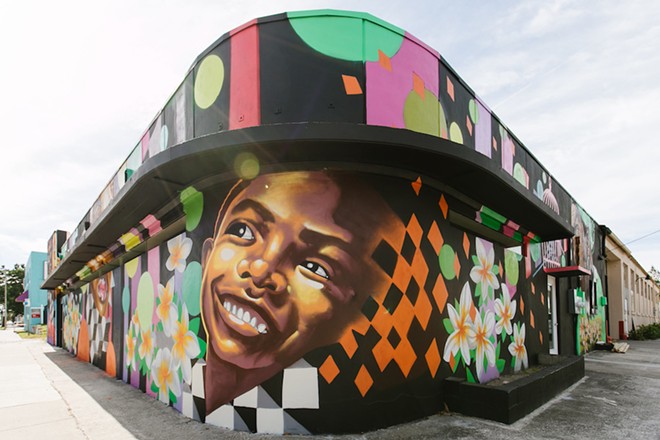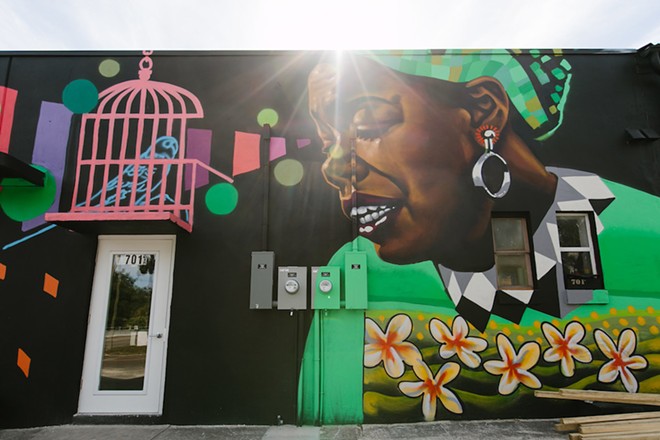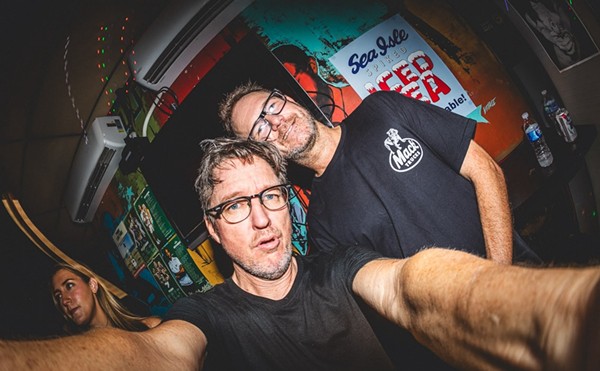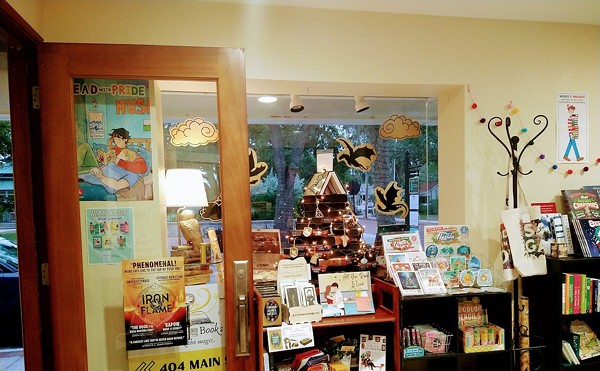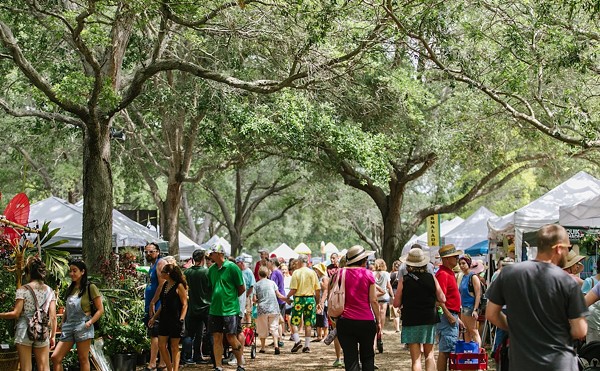St. Petersburg is a city that has used the power of public art to foster community
There's a good argument that investment in public art actually translates into positive outcomes for residents.
By Melanie Rizzo on Thu, Jan 27, 2022 at 2:34 pm
Art has been central to human civilization since the beginnings of recorded history. Throughout our history, humans have used imagery, stories, dancing and music as part of our healing rituals. The examination of art as it relates to wellness is an ongoing area of research within the arena of public health. The most apparent and accessible form of art is public art, which has the capacity to transform a landscape from a once dilapidated and blighted place to a vibrant and beautiful community, a shift which is also reflected in the community's wellness itself.
Here in Tampa Bay, St. Petersburg is an example of a city that has used the power of public art to foster community. A quick drive down Central Avenue is all it takes to see that the common thread between the city's public spaces and the vitality of its residents culminates in the art; a kaleidoscope of colors that weaves together this dynamic community. Through grass-roots organizations and city-wide initiatives, St. Pete has empowered artists and utilized art as a tool for healing, growth and rejuvenation.
The Shine Mural Festival (stylized "SHINE") and the St. Petersburg Arts Alliance is responsible for facilitating the creation of over 500 murals since its inception in 2015. Shine has hosted internationally acclaimed artists, such as Frankfurt-based Case Maclaim, who contributed a piece at this year's festival on 2700-block of Central Avenue next to Casita Taqueria. "A lot of the artists that come for Shine are either national or international artists [who] have painted in a lot of other places. We consistently hear over and over again how much St. Pete shows up for Shine. The people here love Shine. You feel it, there's this energy in the city. People care about what's going on. They want to talk to the artists. They want to understand the art and participate as much as they can," says Jenee Priebe, Director at Shine.
Nearly 80% of Americans live in close proximity to a metropolitan area. The physical features of an environment influence the way residents live, work and navigate the cityscape. A given landscape has the capacity to impact how residents behave, their mobility and their overall sense of well-being. Blighted neighborhoods are shown to promote alienation, social disorder, crime and littering, which in turn, negatively impacts health and well-being. However, public art, when developed and installed in community spaces, can impact the community's health in a myriad of positive ways. Public art engages community members and can increase their sense of identity and belonging, reducing isolation and negative mental and emotional outcomes.
With over 500 murals, numerous sculptures, installations, art museums and galleries, St. Petersburg has positioned itself as an epicenter of art in Tampa Bay. Investments in public art are part of a "place making" initiative for many cities that seek to revitalize spaces while simultaneously reinvigorating the community itself—but does the investment in public art actually translate into positive outcomes for the residents themselves?
Local art therapists would argue, yes.
"We have a lot of external problems in our world that can make people feel helpless or hopeless, and art, if presented in a certain way, can help someone experience a sense of agency and autonomy," says Debra "Vivi" Steinfeld, an art therapist and licensed mental health counselor at Integrative Counsel in St. Petersburg. "It's a benefit to the community. It supports art and creativity. It supports the sharing of ideas. It exposes people to concepts and experiences they may not have had access to before. It promotes tolerance and conversation."
Access to arts and culture is a growing area of focus for urban areas. Research suggests that democratizing access to arts and culture by removing barriers such as entry to a museum, and developing initiatives to proactively engage excluded groups by including them in decision making actually promotes a sense of belonging and social cohesion. A sense of inclusion in turn, promotes pride in the community, both of which positively impact well-being.
"Public art is an equalizer. It is accessible to everyone regardless of their status or their ability to access privately-held collections such as those in museums. This in itself can be very healing," Vivi, continues.
Arts and culture provide value to resident's everyday lives. It is through this everyday cultural participation that social bonds are formed and communities are developed. Public art fulfills the intangible human need for meaning and relevance, by experiencing art in our own community, a person's daily experience can be profound rather than mundane.
The public's investment in art has contributed to a burgeoning economy for St. Petersburg residents and a host of new opportunities. The opportunity for economic growth derived from public art is yet another factor that enriches the lives of St. Pete's residents. Monica DeChaine, a St. Petersburg local and self-proclaimed "Street Art Curator," is the founder of Mural Cycle, a bike tour that immerses and guides people's interactions with St. Petersburg's many murals.
DeChaine was inspired to start her business to share her local knowledge and love for art. Her years of involvement within the community and her connection to the artists themselves is what sets her tours apart, "I get to know the artists before doing the tours and once I hear their side of the story, I'm able to share the true meaning behind their pieces," she says.
By maintaining the integrity of the artist's intended message, Monica hopes that her tour guests will feel more connected to the art and therefore, to the streets of the city themselves.
It has long been established that health is impacted by our emotions, the ability to decrease stress, elicit awe and develop a shared identity with our community evokes a sense of meaning in our lives and contributes to our overall health. A study by UC Berkeley found that positive emotions are markers of good health. Psychologist Dacher Keltner, a co-author of the study, states, "Things we do to experience these [positive] emotions—a walk in nature, losing oneself in music, beholding art—has a direct influence upon health and life expectancy."
Here in St. Petersburg and in cities all over the world, public art reinforces social connections, provides equal access to culture and boosts local economies, overall fostering improved quality of life for residents.
Public art, whether driven by the community or municipal measures, goes far beyond improving the aesthetic quality of a city, it goes straight to the heart of its community.
Here in Tampa Bay, St. Petersburg is an example of a city that has used the power of public art to foster community. A quick drive down Central Avenue is all it takes to see that the common thread between the city's public spaces and the vitality of its residents culminates in the art; a kaleidoscope of colors that weaves together this dynamic community. Through grass-roots organizations and city-wide initiatives, St. Pete has empowered artists and utilized art as a tool for healing, growth and rejuvenation.
The Shine Mural Festival (stylized "SHINE") and the St. Petersburg Arts Alliance is responsible for facilitating the creation of over 500 murals since its inception in 2015. Shine has hosted internationally acclaimed artists, such as Frankfurt-based Case Maclaim, who contributed a piece at this year's festival on 2700-block of Central Avenue next to Casita Taqueria. "A lot of the artists that come for Shine are either national or international artists [who] have painted in a lot of other places. We consistently hear over and over again how much St. Pete shows up for Shine. The people here love Shine. You feel it, there's this energy in the city. People care about what's going on. They want to talk to the artists. They want to understand the art and participate as much as they can," says Jenee Priebe, Director at Shine.
Nearly 80% of Americans live in close proximity to a metropolitan area. The physical features of an environment influence the way residents live, work and navigate the cityscape. A given landscape has the capacity to impact how residents behave, their mobility and their overall sense of well-being. Blighted neighborhoods are shown to promote alienation, social disorder, crime and littering, which in turn, negatively impacts health and well-being. However, public art, when developed and installed in community spaces, can impact the community's health in a myriad of positive ways. Public art engages community members and can increase their sense of identity and belonging, reducing isolation and negative mental and emotional outcomes.
With over 500 murals, numerous sculptures, installations, art museums and galleries, St. Petersburg has positioned itself as an epicenter of art in Tampa Bay. Investments in public art are part of a "place making" initiative for many cities that seek to revitalize spaces while simultaneously reinvigorating the community itself—but does the investment in public art actually translate into positive outcomes for the residents themselves?
Local art therapists would argue, yes.
"We have a lot of external problems in our world that can make people feel helpless or hopeless, and art, if presented in a certain way, can help someone experience a sense of agency and autonomy," says Debra "Vivi" Steinfeld, an art therapist and licensed mental health counselor at Integrative Counsel in St. Petersburg. "It's a benefit to the community. It supports art and creativity. It supports the sharing of ideas. It exposes people to concepts and experiences they may not have had access to before. It promotes tolerance and conversation."
Access to arts and culture is a growing area of focus for urban areas. Research suggests that democratizing access to arts and culture by removing barriers such as entry to a museum, and developing initiatives to proactively engage excluded groups by including them in decision making actually promotes a sense of belonging and social cohesion. A sense of inclusion in turn, promotes pride in the community, both of which positively impact well-being.
"Public art is an equalizer. It is accessible to everyone regardless of their status or their ability to access privately-held collections such as those in museums. This in itself can be very healing," Vivi, continues.
Arts and culture provide value to resident's everyday lives. It is through this everyday cultural participation that social bonds are formed and communities are developed. Public art fulfills the intangible human need for meaning and relevance, by experiencing art in our own community, a person's daily experience can be profound rather than mundane.
The public's investment in art has contributed to a burgeoning economy for St. Petersburg residents and a host of new opportunities. The opportunity for economic growth derived from public art is yet another factor that enriches the lives of St. Pete's residents. Monica DeChaine, a St. Petersburg local and self-proclaimed "Street Art Curator," is the founder of Mural Cycle, a bike tour that immerses and guides people's interactions with St. Petersburg's many murals.
DeChaine was inspired to start her business to share her local knowledge and love for art. Her years of involvement within the community and her connection to the artists themselves is what sets her tours apart, "I get to know the artists before doing the tours and once I hear their side of the story, I'm able to share the true meaning behind their pieces," she says.
By maintaining the integrity of the artist's intended message, Monica hopes that her tour guests will feel more connected to the art and therefore, to the streets of the city themselves.
It has long been established that health is impacted by our emotions, the ability to decrease stress, elicit awe and develop a shared identity with our community evokes a sense of meaning in our lives and contributes to our overall health. A study by UC Berkeley found that positive emotions are markers of good health. Psychologist Dacher Keltner, a co-author of the study, states, "Things we do to experience these [positive] emotions—a walk in nature, losing oneself in music, beholding art—has a direct influence upon health and life expectancy."
Here in St. Petersburg and in cities all over the world, public art reinforces social connections, provides equal access to culture and boosts local economies, overall fostering improved quality of life for residents.
Public art, whether driven by the community or municipal measures, goes far beyond improving the aesthetic quality of a city, it goes straight to the heart of its community.
Tags:

WE LOVE OUR READERS!
Since 1988, CL Tampa Bay has served as the free, independent voice of Tampa Bay, and we want to keep it that way.
Becoming a CL Tampa Bay Supporter for as little as $5 a month allows us to continue offering readers access to our coverage of local news, food, nightlife, events, and culture with no paywalls.
Scroll to read more Local Arts articles
Newsletters
Join Creative Loafing Tampa Bay Newsletters
Subscribe now to get the latest news delivered right to your inbox.

